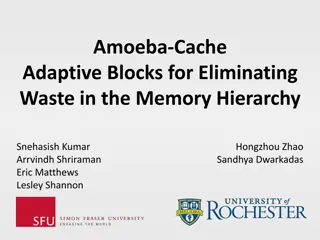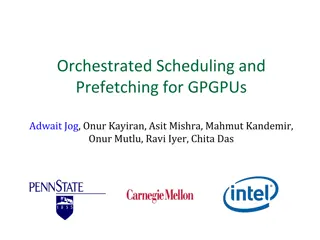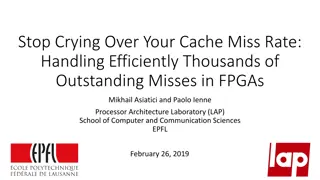Efficient Instruction Cache Prefetching Techniques
Discussion on issues and solutions related to instruction cache prefetching, including trigger timing, next-line prefetching, I-Shadow cache, and footprint prediction. Evaluation results show improved performance with FNL methodology compared to traditional prefetching methods.
Uploaded on Nov 19, 2024 | 0 Views
Download Presentation

Please find below an Image/Link to download the presentation.
The content on the website is provided AS IS for your information and personal use only. It may not be sold, licensed, or shared on other websites without obtaining consent from the author.If you encounter any issues during the download, it is possible that the publisher has removed the file from their server.
You are allowed to download the files provided on this website for personal or commercial use, subject to the condition that they are used lawfully. All files are the property of their respective owners.
The content on the website is provided AS IS for your information and personal use only. It may not be sold, licensed, or shared on other websites without obtaining consent from the author.
E N D
Presentation Transcript
1 The FNL-MMA instruction cache prefetcher Andr Seznec INRIA/IRISA
2 The I-cache issue High miss rates on new servers and client applications No easy access to traces of applications with large instruction footprint. Thanks to the IPC organizers
3 Prefetching issues When to trigger prefetches ? On misses: too late On every access: too many Somewhere between .. Which lines to prefetch ? Next line(s) Consecutively used lines Need both How to prefetch timely ?
4 The I-Shadow cache A small tag cache for demand misses 3-way 64-entry: < I-cache size, but not that much Miss on I-cache without prefetching also I-Shadow miss Trigger prefetch on I-Shadow miss
Next-line prefetching is working some kind of 5 Next line on I-Shadow misses 1.093 speed-up 45 % extra L2 accesses 5 next lines on I-Shadow misses: 1.087 speed-up 3x extra L2 accesses Let us get rid of these extra L2 accesses
6 Footprint Next Line prefetcher Prefetch next-line(s) only if (very likely) to be used And several cache lines !! Predict the next line(s) footprint
7 Predicting next-line use (1) Two (large) direct-mapped tables to monitor application footprint Touched : 1 bit WorthPF: 2 bits
8 Predicting next-line use (2) On an I-Shadow cache miss on block B Set Touched[B] 1 1 If Touched[B-1] WorthPF[B-1]=3 2 3 0 1 1 If WorthPF[B] prefetch B+1 and B+2 and B+3, but not B+4
9 Used in a reasonable future Smart resetting for Touched and WorthPF every 8K I-Shadow misses If Touched[B] WorthPF[B]--; Touched[B]=0;
10 FNL evaluation 64Kentry i.e. 24 KB Up to 1 line: 1.124 Up to 3 lines: 1.159 Up to 5 lines: 1.165 1.148 with 3KB Much better than pure next-line prefetching at a limited 11.8 % extra L2 accesses
11 Prefetching consecutively used blocks Without prefetcher, miss on B is often followed by miss on C Intuition: Prefetch C !! Too late if one waits for the miss on B Prefetching destroys the correlation
12 Next Miss Prefetcher Use the I-Shadow cache to predict the next I-cache miss Associate B and C when B and C miss consecutively on I-Shadow AND AND C misses on the I-cache Prefetch C after two successive occurences
13 Next Miss prefetcher I-shadow miss sequence I-cache miss miss I-cache 1. 2. 3 and more. Bb Cc Associate C to Bb in the Next Miss table to high confidence Set (Bb,C) entry Prefetch C on Bb I-Shadow miss
14 Next Miss Prefetcher (3) Very accurate: 1% extra L2 accesses Unfortunately often late: Halves the average miss latency Reasonable speed-up: 1.122 FNL + NMP: 1.226 speed-up +23.1 % L2 accesses
A step further: 15 Multiple Miss Ahead prefetcher To avoid late prefetching: just prefetch earlier !! I-shadow miss sequence B B1 B2 B3 B4 B5 B6 B7 B8 B9 NMP 9-miss ahead
16 MMA prefetcher Triggered by I-Shadow cache miss Associate B9 with B if B9 is 9th miss on I-Shadow after B AND AND B9 misses the I-cache Prefetch after two successive occurrences
17 The submitted prefetcher FNL5+MMA9: Up to 5 next-line + 9-miss ahead FNL5: 64Kentries Touched and WorthPF 24 KB MMA9: 8Kentries 9-miss ahead table 71 bits per entry: 58 (addr) +12 (tag) +1 71 KB 1.287 speed-up 38.3 % extra L2 accesses 91.8 % miss reduction
Extra filters (not useful on Championship framework, but needed on effective hardware) 18 Filter FNL5 requests: block B-1 recently prefetched or missing I-Shadow only try to prefetch B+5 Filter MMA requests: Do not prefetch again recently prefetched blocks
19 Further experiments (1) The I-Shadow should be updated at commit time (to avoid wrong path pollution) Longer ahead distance ?? FNL5+MMA30 Speed-up : 1.284 Extra L2 accesses: 48.5 % Tolerate prefetching at commit time
20 Further experiments (2) FNL FNL5 5+MMA +MMA9 9 FNL5 FNL5 MMA9 MMA9 Full size (96KB) 1.287 1.165 1.211 1/2th (48KB) 1.284 1.163 1.186 1/4th. (24KB) 1.273 1.158 1.133 1/8th (12KB) 1.241 1.148 1.078 Combining FNL and MMA allows good performance at reasonable storage budgets
Prefetchers work in physical address space 21 MMA too !!: Smaller tables: 58 bits 42 bits address FNL cannot cross page boundaries 1.284 speed-up
22 Summary FNL: prefetch only useful next lines Multiple miss ahead: simple, accurate, and timely But needs huge miss ahead tables FNL+MMA: Efficient combination with affordable storage budget
An optimization developed after deadline 23 Better miss address prediction: 1.293 speed-up 95.9 % miss reduction
24 Questions: Andre.Seznec@inria.fr























